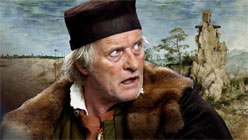From the outset, the filmmaker brings to life the dense panorama of the painting and its panoply of characters in a way that’s neither special effect nor carnival trick, but rather makes us feel as if we are witnessing real people cajoled from the daily routine of their lives by the artist. (Majewski sees Breugel, in other words, and raises him.) Then the director imagines a few of these lives, with their reliance on natural light, home-raised food, carnal necessities and neighborly cooperation.
A miller, aloft on a mountain looking down on the people, rises in the morning and begins his workaday preparations. In another abode, children awaken, tease each other, chomp on a breakfast of bread and go outdoors to play. Elsewhere, a couple makes love, then sets out with their cow for a walk.
The painter (a ruggedly cerebral Rutger Hauer) accommodatingly explains to us, via conversation with a haughtily obtuse, upper-crust collector friend (Michael York), the symbols and metaphors in his work. The circle of life and the circle of death is one that sticks with me, perhaps because it was so simple I had no trouble grasping it.

I saw The Mill and the Cross at the S.F. International Film Festival in the spring and again a few weeks ago, and I’ll admit that both times my thoughts wandered occasionally and my eyelids grew heavy. Not, however, when a passel of unsmiling men in red tunics rode out of the foggy haze, the pounding of their horses’ hooves portending an ill fate for some poor soul as yet unaware.
These men are part of the occupying Spanish army, and their prey on this gray day turns out to be one of the innocents I mentioned earlier. Onward, Christian soldiers indeed.

The Mill and the Cross is simultaneously a work of literacy and mystery, of explication and suggestion. It bears the opaque light of Breugel’s painting, and devotes great attention to costumes, but it does not strive too strenuously for period effect. It is as if we are allowed, for a few curious hours, to inhabit the 16th century. And when we end our visit, stepping out of and away from “The Way to Calvary” in the Kunsthistoriches Museum in Vienna, we are extremely grateful to be alive in our own time.

It would be helpful to see The Mill and the Cross with an art historian, but it’s hardly essential. I’m an adherent of the “you get what you get” school of moviegoing, which is to say I’m not endorsing malign ignorance so much as endorsing the possibility of unexpected revelation. Frankly, not many moviemakers these days are up to conjuring that kind of wispy magic.
The Mill and the Cross opens Friday, September 30, 2011 at the Embarcadero Center Cinema in San Francisco and the Shattuck in Berkeley.







